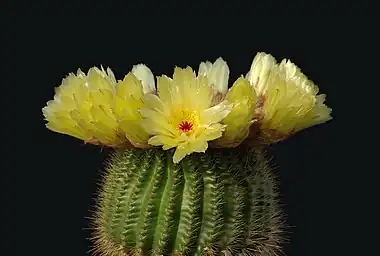Parodia tenuicylindrica
Parodia tenuicylindrica is a species of cactus from the genus Parodia. The small green cacti have yellow and red-brown spines, white wool and yellow flowers. They produce yellow-green fruit, and black seeds. P. tenuicylindrica can be found growing individually in Rio Grande do Sul, Brazil.
| Parodia tenuicylindrica | |
|---|---|
 | |
| Scientific classification | |
| Kingdom: | Plantae |
| Clade: | Tracheophytes |
| Clade: | Angiosperms |
| Clade: | Eudicots |
| Order: | Caryophyllales |
| Family: | Cactaceae |
| Subfamily: | Cactoideae |
| Genus: | Parodia |
| Species: | P. tenuicylindrica |
| Binomial name | |
| Parodia tenuicylindrica (F.Ritter) D.R.Hunt | |
| Synonyms[1] | |
| |
Taxonomy
The species was originally described as Notocactus minimus by Frič & Kruizinger in 1940, based on a description by Bruining. It was later described as Notocactus tenuicylindricus by Friedrich Ritter.[1] Despite objections from hobbyists (among whom Notocactus species were popular) Notocactus (and others) were synonymised under Parodia.[2] In 1997, based on Ritter's earlier description, D. R. Hunt classified the species as Parodia tenuicylindrica.[1]
Description
Parodia tenuicylindrica are cylindrical cacti which are green to blue-green.[1] In height, they are 4 to 8 centimetres (1.6 to 3.1 in) and are from 2 to 3 centimetres (0.79 to 1.18 in) in width.[1] The plants have 13-21 notched and tuberculate ribs.[1] On top of the tubercles, there are areoles with white wool. The species has straight and stout spines; the radial spines, of which there are between ten and fifteen, are pale yellow, and between 3 and 4 millimetres (0.12 and 0.16 in) in length, while the 2-4 red-brown central spines are between 3 and 6 millimetres (0.12 and 0.24 in) long.[1] The species produces lemon yellow flowers (which are up to 4.3 centimetres (1.7 in) long) and greenish-yellow fruits. The seeds are black oblongs with tubercles.[1]
Distribution
Parodia tenuicylindrica can be found growing solitarily in Rio Grande do Sul, Brazil.[1] It is currently classified as Endangered (EN) on the IUCN Red List, with major threats reported to be fires, cattle grazing due to trampling, agriculture, and forestry.
References
- Anderson, Edward F. (2001). The cactus family. Timber Press. p. 555. ISBN 978-0-88192-498-5.
- Eggli, U.; Nyffeler, R. (1998). "Proposal to Conserve the Name Parodia against Frailea (Cactaceae)". Taxon. 47 (2): 475–6. doi:10.2307/1223792. ISSN 0040-0262. JSTOR 1223792.